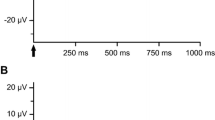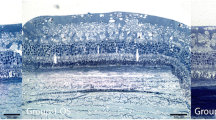Abstract
Purpose
Indocyanine green (ICG) has been widely used as a vital dye for macular surgery. However, ICG can be toxic to retinal cells. Here we evaluate whether tempol (4-hydroxy-2,2,6,6-tetramethylpiperidine-1-oxyl), a free radical scavenger, can protect against ICG-induced retinal damage in rats.
Methods
Brown Norway rats received intravitreal injections of ICG 0.5 % or BSS as controls. Tempol (20 mg/kg BW) or PBS as a control was administered intraperitoneally 24 h and 30 min before ICG and once daily for 7 consecutive days. Tempol was detected in the retina using electron paramagnetic resonance (EPR) spectroscopy. One week after ICG injections, the effects of tempol on retinal toxicity were assessed by retinal ganglion cell (RGC) back-labeling and by light microscopy. Electroretinography (ERG) was performed after 1 and 2 weeks.
Results
ICG administration reduced RGC numbers by 17 % (1,943 ± 45 vs. 2,342 ± 31 RGCs/mm2). Tempol treatment rescued RGCs in a significant manner (2,258 ± 36, p < 0.01) and diminished morphological changes detected by light microscopy. ICG-injected eyes showed a significant reduction of ERG potentials only in PBS-treated animals (Vmax 530 ± 145 µV vs. 779 ± 179 µV, p = 0.0052), but not in the tempol-treated group.
Conclusions
Tempol significantly attenuates ICG-induced toxicity in rat retinas and may therefore be considered for further evaluation as accompanying treatment in ICG-assisted chromovitrectomy.






Similar content being viewed by others
References
Stanescu-Segall D, Jackson TL (2009) Vital staining with indocyanine green: a review of the clinical and experimental studies relating to safety. Eye (Lond) 23:504–518
Sippy BD, Engelbrecht NE, Hubbard GB, Moriarty SE, Jiang S, Aaberg TM Jr, Aaberg TM Sr, Grossniklaus HE, Sternberg P Jr (2001) Indocyanine green effect on cultured human retinal pigment epithelial cells: implication for macular hole surgery. Am J Ophthalmol 132:433–435
Enaida H, Sakamoto T, Hisatomi T, Goto Y, Ishibashi T (2002) Morphological and functional damage of the retina caused by intravitreous indocyanine green in rat eyes. Graefes Arch Clin Exp Ophthalmol 240:209–213
Haritoglou C, Gandorfer A, Gass CA, Schaumberger M, Ulbig MW, Kampik A (2002) Indocyanine green-assisted peeling of the internal limiting membrane in macular hole surgery affects visual outcome: a clinicopathologic correlation. Am J Ophthalmol 134:836–841
Da Mata AP, Burk SE, Riemann CD, Rosa RH Jr, Snyder ME, Petersen MR, Foster RE (2001) Indocyanine green-assisted peeling of the retinal internal limiting membrane during vitrectomy surgery for macular hole repair. Ophthalmology 108:1187–1192
Lochhead J, Jones E, Chui D, Lake S, Karia N, Patel CK, Rosen P (2004) Outcome of ICG-assisted ILM peel in macular hole surgery. Eye 18:804–808
Grisanti S, Szurman P, Gelisken F, Aisenbrey S, Oficjalska-Mlynczak J, Bartz-Schmidt KU (2004) Histological findings in experimental macular surgery with indocyanine green. Invest Ophthalmol Vis Sci 45:282–286
Remy M, Thaler S, Schumann RG, May CA, Fiedorowicz M, Schuettauf F, Gruterich M, Priglinger SG, Nentwich MM, Kampik A, Haritoglou C (2008) An in vivo evaluation of Brilliant Blue G in animals and humans. Br J Ophthalmol 92:1142–1147
Lanzetta P, Polito A, Del BM, Narayanan R, Shah VA, Frattolillo A, Bandello F (2006) Idiopathic macular hole surgery with low-concentration infracyanine green-assisted peeling of the internal limiting membrane. Am J Ophthalmol 142:771–776
Facino M, Mochi B, Lai S, Terrile R (2004) A simple way to prevent indocyanine green from entering the subretinal space during vitrectomy for retinal detachment due to myopic macular hole. Eur J Ophthalmol 14:269–271
Nakamura H, Hayakawa K, Sawaguchi S, Gaja T (2005) Removal of retinal indocyanine green dye by autologous serum irrigation in macular hole surgery. Retina 25:736–741
Grisanti S, Altvater A, Peters S (2008) Safety parameters for indocyanine green in vitreoretinal surgery. Dev Ophthalmol 42:43–68
Yam HF, Kwok AK, Chan KP, Lai TY, Chu KY, Lam DS, Pang CP (2003) Effect of indocyanine green and illumination on gene expression in human retinal pigment epithelial cells. Invest Ophthalmol Vis Sci 44:370–377
Saikia P, Maisch T, Kobuch K, Jackson TL, Baumler W, Szeimies RM, Gabel VP, Hillenkamp J (2006) Safety testing of indocyanine green in an ex vivo porcine retina model. Invest Ophthalmol Vis Sci 47:4998–5003
Murata M, Shimizu S, Horiuchi S, Sato S (2005) The effect of indocyanine green on cultured retinal glial cells. Retina 25:75–80
Rezai KA, Farrokh-Siar L, Ernest JT, van Seventer GA (2004) Indocyanine green induces apoptosis in human retinal pigment epithelial cells. Am J Ophthalmol 137:931–933
Hsu SL, Kao YH, Wu WC (2004) Effect of indocyanine green on the growth and viability of cultured human retinal pigment epithelial cells. J Ocul Pharmacol Ther 20:353–362
Ueno A, Hisatomi T, Enaida H, Kagimoto T, Mochizuki Y, Goto Y, Kubota T, Hata Y, Ishibashi T (2007) Biocompatibility of brilliant blue G in a rat model of subretinal injection. Retina 27:499–504
Schuettauf F, Haritoglou C, May CA, Rejdak R, Mankowska A, Freyer W, Eibl K, Zrenner E, Kampik A, Thaler S (2006) Administration of novel dyes for intraocular surgery: an in vivo toxicity animal study. Invest Ophthalmol Vis Sci 47:3573–3578
Beit-Yannai E, Zhang R, Trembovler V, Samuni A, Shohami E (1996) Cerebroprotective effect of stable nitroxide radicals in closed head injury in the rat. Brain Res 717:22–28
Lipman T, Tabakman R, Lazarovici P (2006) Neuroprotective effects of the stable nitroxide compound tempol on 1-methyl-4-phenylpyridinium ion-induced neurotoxicity in the nerve growth factor-differentiated model of pheochromocytoma PC12 cells. Eur J Pharmacol 549:50–57
Liang Q, Smith AD, Pan S, Tyurin VA, Kagan VE, Hastings TG, Schor NF (2005) Neuroprotective effects of TEMPOL in central and peripheral nervous system models of Parkinson's disease. Biochem Pharmacol 70:1371–1381
Thaler S, Fiedorowicz M, Rejdak R, Choragiewicz TJ, Sulejczak D, Stopa P, Zarnowski T, Zrenner E, Grieb P, Schuettauf F (2010) Neuroprotective effects of tempol on retinal ganglion cells in a partial optic nerve crush rat model with and without iron load. Exp Eye Res 90:254–260
Wang M, Lam TT, Fu J, Tso MO (1995) TEMPOL, a superoxide dismutase mimic, ameliorates light-induced retinal degeneration. Res Commun Mol Pathol Pharmacol 89:291–305
Mitchell JB, Samuni A, Krishna MC, DeGraff WG, Ahn MS, Samuni U, Russo A (1990) Biologically active metal-independent superoxide dismutase mimics. Biochemistry 29:2802–2807
Hahn SM, Tochner Z, Krishna CM, Glass J, Wilson L, Samuni A, Sprague M, Venzon D, Glatstein E, Mitchell JB (1992) Tempol, a stable free radical, is a novel murine radiation protector. Cancer Res 52:1750–1753
Thaler S, Haritoglou C, Choragiewicz TJ, Messias A, Baryluk A, May CA, Rejdak R, Fiedorowicz M, Zrenner E, Schuettauf F (2008) In vivo toxicity study of rhodamine 6G in the rat retina. Invest Ophthalmol Vis Sci 49:2120–2126
Thaler S, Schuettauf F, Fiedorowicz M, Messias A, Schatz A, Choragiewicz TJ, May CA, Zrenner E, Kampik A, Haritoglou C (2009) In vivo toxicity testing of methyl blue and aniline blue as vital dyes for intraocular surgery. Retina 29:1257–1265
Naka KI, Rushton WA (1966) S-potentials from luminosity units in the retina of fish (Cyprinidae). J Physiol 185:587–599
Stalmans P, Van Aken EH, Veckeneer M, Feron EJ, Stalmans I (2002) Toxic effect of indocyanine green on retinal pigment epithelium related to osmotic effects of the solvent. Am J Ophthalmol 134:282–285
Iriyama A, Uchida S, Yanagi Y, Tamaki Y, Inoue Y, Matsuura K, Kadonosono K, Araie M (2004) Effects of indocyanine green on retinal ganglion cells. Invest Ophthalmol Vis Sci 45:943–947
Tsuhako MH, Augusto O, Linares E, Chadi G, Giorgio S, Pereira CA (2010) Tempol ameliorates murine viral encephalomyelitis by preserving the blood–brain barrier, reducing viral load, and lessening inflammation. Free Radic Biol Med 48:704–712
Rak R, Chao DL, Pluta RM, Mitchell JB, Oldfield EH, Watson JC (2000) Neuroprotection by the stable nitroxide tempol during reperfusion in a rat model of transient focal ischemia. J Neurosurg 92:646–651
Zamir E, Zhang R, Samuni A, Kogan M, Pe'er J (1999) Nitroxide stable radical suppresses autoimmune uveitis in rats. Free Radic Biol Med 27:7–15
Maia M, Margalit E, Lakhanpal R, Tso MO, Grebe R, Torres G, Au Eong KG, Farah ME, Fujii GY, Weiland J, de Juan E, Jr D'Anna SA, Humayun MS (2004) Effects of intravitreal indocyanine green injection in rabbits. Retina 24:69–79
Kanda S, Uemura A, Yamashita T, Kita H, Yamakiri K, Sakamoto T (2004) Visual field defects after intravitreous administration of indocyanine green in macular hole surgery. Arch Ophthalmol 122:1447–1451
Gass CA, Haritoglou C, Schaumberger M, Kampik A (2003) Functional outcome of macular hole surgery with and without indocyanine green-assisted peeling of the internal limiting membrane. Graefes Arch Clin Exp Ophthalmol 241:716–720
Beutel J, Dahmen G, Ziegler A, Hoerauf H (2007) Internal limiting membrane peeling with indocyanine green or Trypan blue in macular hole surgery: a randomized trial. Arch Ophthalmol 125:326–332
Ashikari M, Ozeki H, Tomida K, Sakurai E, Tamai K, Ogura Y (2006) Long-term retention of dye after indocyanine green-assisted internal limiting membrane peeling. Jpn J Ophthalmol 50:349–353
Sekiryu T, Iida T (2007) Long-term observation of fundus infrared fluorescence after indocyanine green-assisted vitrectomy. Retina 27:190–197
Mehlhorn RJ, Swanson CE (1992) Nitroxide-stimulated H2O2 decomposition by peroxidases and pseudoperoxidases. Free Radic Res Commun 17:157–175
Samuni AM, Chuang EY, Krishna MC, Stein W, Degraff W, Russo A, Mitchell JB (2003) Semiquinone radical intermediate in catecholic estrogen-mediated cytotoxicity and mutagenesis: chemoprevention strategies with antioxidants. Proc Natl Acad Sci USA 100:5390–5395
Engel E, Schraml R, Maisch T, Kobuch K, Konig B, Szeimies RM, Hillenkamp J, Baumler W, Vasold R (2008) Light-induced decomposition of indocyanine green. Invest Ophthalmol Vis Sci 49:1777–1783
Yip HK, Lai TY, So KF, Kwok AK (2006) Retinal ganglion cells toxicity caused by photosensitising effects of intravitreal indocyanine green with illumination in rat eyes. Br J Ophthalmol 90:99–102
Haritoglou C, Priglinger S, Gandorfer A, Welge-Lussen U, Kampik A (2005) Histology of the vitreoretinal interface after indocyanine green staining of the ILM, with illumination using a halogen and xenon light source. Invest Ophthalmol Vis Sci 46:1468–1472
Hahn SM, Sullivan FJ, DeLuca AM, Bacher JD, Liebmann J, Krishna MC, Coffin D, Mitchell JB (1999) Hemodynamic effect of the nitroxide superoxide dismutase mimics. Free Radic Biol Med 27:529–535
Acknowledgements
S. Thaler and F. Schuettauf were supported by the Neuroophthalmologische Gesellschaft, Tuebingen, Germany, in form of a research grant.
The authors want to thank Katarzyna Zawada, Warsaw, Poland, for her excellent support.
Author information
Authors and Affiliations
Corresponding author
Rights and permissions
About this article
Cite this article
Thaler, S., Voykov, B., Willmann, G. et al. Tempol protects against intravitreous indocyanine green-induced retinal damage in rats. Graefes Arch Clin Exp Ophthalmol 250, 1597–1606 (2012). https://doi.org/10.1007/s00417-012-2000-1
Received:
Revised:
Accepted:
Published:
Issue Date:
DOI: https://doi.org/10.1007/s00417-012-2000-1




